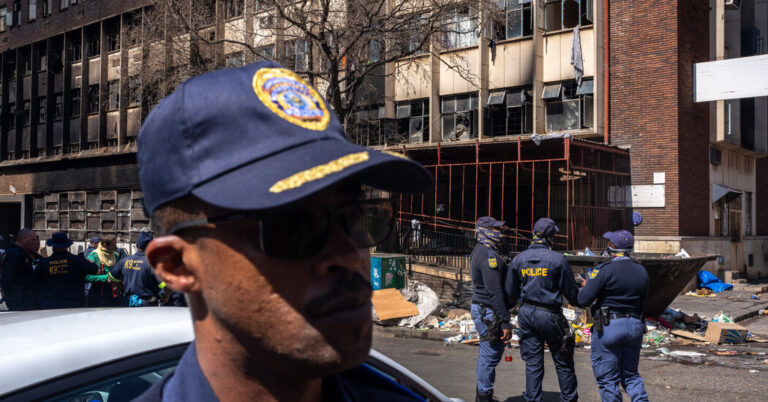The South African police have arrested a man who confessed to having caused a fire that killed 77 people in a derelict building in downtown Johannesburg last year after a drug dispute led him to strangle a man and set the body alight, a police spokeswoman and a victims’ advocate said on Wednesday.
The man, a 29-year-old whose name has not been released, was arrested on Tuesday on 77 counts of murder and 120 counts of attempted murder, said Col. Dimakatso Nevhuhulwi, a spokeswoman for the police in Gauteng Province, which includes Johannesburg. Colonel Nevhuhulwi initially gave the figure as 76 counts, but then clarified that it was 77.
The man made his confession during a hearing of a special commission investigating the fire, which tore through an overcrowded five-story building in the early hours of Aug. 31. The commission was later told that the exact death toll was unclear because of how badly some of the bodies were burned.
“We were shocked when he incriminated himself,” said Andy Chinnah, an advocate for the victims who was briefed on the testimony by lawyers at Norton Rose Fulbright, which is representing the victims.
In preparation for the commission hearing, which started last year, Mr. Chinnah said that he and other activists had interviewed more than 300 survivors. While there were theories that the blaze could have been the result of a drug deal gone bad, a domestic dispute or an attempt to destroy corpses in the building, the suspect’s testimony seemed to come out of nowhere.
“Do I believe him?” Mr. Chinnah said. “Nothing’s impossible. But right now it just doesn’t make sense for one body to be set alight and cause such a big fire.”
Although the evidence presented in the hearings is not usable in a criminal investigation, the suspect told the commission that he had also confessed to the police, according to Nomzamo Zondo, a lawyer who is the executive director of the Socio-Economic Rights Institute and who listened to the man’s confession.
The man is set to appear in a Johannesburg court on Thursday, the police said. They did not respond to a question on whether the suspect had confessed to them.
Testifying at the hearing behind closed doors to protect his identity, the suspect said that a drug dealer he worked with in the building had called him to deal with someone who had gotten into a dispute with the dealer, Mr. Chinnah said. A lawyer with Norton Rose Fulbright confirmed Mr. Chinnah’s account of the testimony.
The suspect said that he and the dealer had taken the man into an office in the building with a bag over his head and beat him up, Mr. Chinnah said. When the dealer left, the suspect removed the bag and realized that he knew the person they had just assaulted. In a panic, he strangled him, Mr. Chinnah said. He then went to a gas station to get gas, returned to the building and doused the body before setting it on fire, Mr. Chinnah said.
The suspect testified that he had been high on drugs at the time and did not think the fire would spread the way it did. He said he had felt guilty as he stood outside and saw a woman and her child spring out of the building from a window, trying to escape the inferno, according to Mr. Chinnah.
The man wept as he spoke, describing the guilt and fear that he said had led to his confession, Ms. Zondo said. He, too, had lived in the building, he told the commission, and in trying to escape homelessness, he had become entangled in criminality.
On the night of the fire, a neighbor had spotted him carrying gasoline into the building and questioned why a man with no car would need fuel. In the aftermath of the blaze, that neighbor persuaded the suspect to turn himself in, the man said in his testimony. That neighbor also testified before the commission a day earlier, Ms. Zondo said.
The fire focused international attention on hundreds of rundown, illegally occupied buildings in Johannesburg like the one that burned, where poor families who cannot afford more secure housing have settled. These urban squatter camps are known as “hijacked” buildings, because gangs that deal drugs often take over them and extort residents for rent payments.
The commission investigating the fire halted its work last year after the burned building was itself deemed to be a fire hazard. Its hearings resumed this month.
The hearings have been live-streamed, but the man testified behind closed doors out of fear that gang leaders who operated out of the building would have him killed, the commission’s lead attorney said.
“His life may be in peril if made public,” the attorney, Ishmael Semenya, said during a public portion of the hearing.
As the police continue their investigation, the building remains bricked up, its entrances cordoned off by barbed wire. The city authorities have housed many of the survivors at a tented camp in Johannesburg.
Those killed in the blaze included at least a dozen children — two of them toddlers named Memory — migrants from other African countries and people holding down jobs as teachers and technicians. Neighbors and residents said the building also housed criminal gangs that sold drugs on the sidewalk and robbed passers-by.
The government owned the building and many others like it. Going block by block and searching records, New York Times reporters last year identified at least 127 similar buildings in the center of Johannesburg.
President Cyril Ramaphosa has called the fire a “wake-up call” for South Africa, where the cost of living puts housing out of reach for many, and where city governments look the other way as people occupy garbage-strewn buildings that lack water or electricity.



